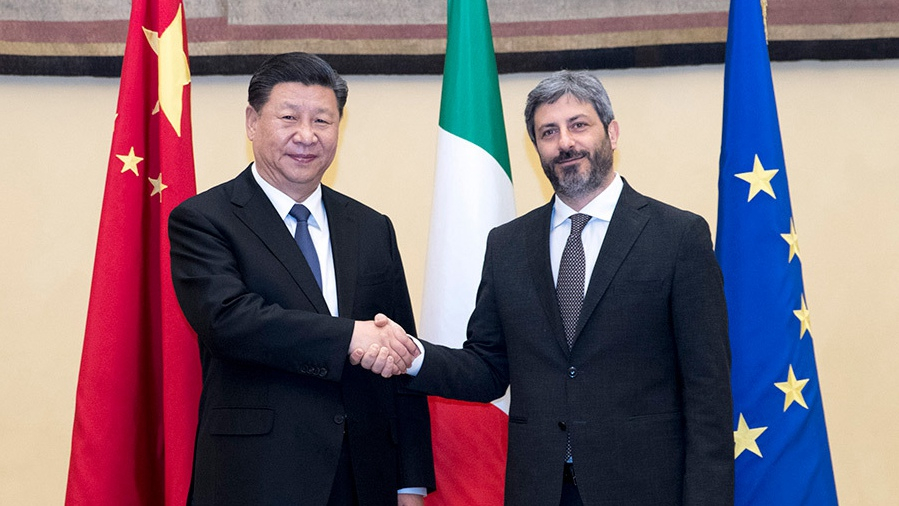
Opinion
12:23, 23-Mar-2019
China, Italy to put more concrete and steel into BRI
Bobby Naderi

Editor's note: Bobby Naderi is a journalist, a current affairs commentator, a documentary filmmaker and a member of the Writers Guild of Great Britain. The article reflects the author's opinion, and not necessarily the views of CGTN.
On Friday, March 22, and on the first leg of his tour, President Xi and his Italian counterpart Sergio Mattarella held a press conference in Rome, during which the two leaders agreed to deepen ties in trade and investment.
President Xi said the two sides will develop strategies “to enhance cooperation in the infrastructure, port, logistics and maritime transport sectors, and build a series of concrete projects” along the Belt and Road Initiative (BRI).
For his part, President Mattarella said Italy is the first G7 country to join the Belt and Road Initiative and receive investment from China. He also said Italy will facilitate China's products reaching Western Europe.
This new development should stun no one. Italy's decision to join the ongoing global development project is the key prize and indeed the highlight of President Xi's state visits to Italy, Monaco and France. According to China's official website of BRI, as of March 6, 2019, the country has signed cooperation agreements with 123 countries. The China-backed global development project has been and still is the chronicle of a diplomatic success foretold. And Italy's addition will only make it much better.
Of course, there are critics and skeptics. And you are at a great disadvantage if you don't take into consideration what they have to say about the BRI and China's diplomatic-economic overtures in Europe.

Chinese President Xi Jinping and his wife Peng Liyuan arrive in Rome, Italy, March 2, for a state visit. /VCG Photo
Chinese President Xi Jinping and his wife Peng Liyuan arrive in Rome, Italy, March 2, for a state visit. /VCG Photo
Explicitly, the naysayers cannot come up with any alternative for the BRI, the biggest development project on earth, which is specifically designed to advance economic, political and diplomatic interests of many countries in each and every corner of the globe. They have no alternative program to replace the massive infrastructure projects that span across Asia, the Middle East, Africa and Europe.
We have seen their unease before. These are the same cynics that in 2015 (together with the United States) panned the United Kingdom for becoming a founding member of the Asian Infrastructure Investment Bank, making it the first Western nation to join the China-backed institution. Much to their chagrin, many countries in Europe and elsewhere followed suit.
On this note, any suggestion that other Eurozone economies might not follow Italy may be premature. The new trade and investment agreements between China and Italy will work with ease, because the BRI is here to stay and benefits both sides, and because they need to deepen bilateral and multilateral ties with the rest of the world. The new development means Beijing can invest in Italian ports where Chinese goods can be imported into Europe, goods can be manufactured in Italy to meet EU standards, and then transported to other EU markets.
In exchange, the new deals will help Italy to attract investments, export Italian products to Chinese markets, and create new job opportunities for its people. The rest, of course, is made-up concerns and politically-motivated claims and suspicions, such as the U.S. alleging that China wants to “break ranks” in the EU or that telecoms giant Huawei could use its next generation 5G technology as a "backdoor" to spy in Italy.
President Xi is not in Europe “to ruffle feathers” or “to cause consternation” within Eurozone economies and among traditional allies. His trip is not an attempt to grow Beijing's economic clout and political influence in Europe and the West, or for Chinese tech companies to snoop on Italian consumers and threaten their personal data.
Far from it, the Chinese leader seeks to promote dialogue and find “points of convergence between Europe and China.” Beijing has invested a lot in the BRI infrastructure projects like railways, roads and ports throughout the globe. It makes no economic sense to sacrifice such a massive investment only “to break ranks” and “to wield influence” in Europe.
In any case, the BRI is already in Europe, and as maintained by the presidents at their press conference, it is beneficial for Chinese-Italian trade and economic development. It is, as well, a template for other free-traders to follow suit.
On March 22, Rome took a leading role on strengthening trade and investment ties with China. The third-biggest economy in the Eurozone is now a model for other industrialized nations and free-traders to follow suit, to work with the second-biggest economy in the world, to put more concrete and steel into the Belt and Road Initiative, and to put themselves on its superhighways.
On that score, and based on the “spirit of equality and reciprocity,” every nation has the right to “make sure the playing field is level” as well, and in no way “weighed in China's interests” economically, politically and diplomatically.
(If you want to contribute and have specific expertise, please contact us at opinions@cgtn.com.)

SITEMAP
Copyright © 2018 CGTN. Beijing ICP prepared NO.16065310-3
Copyright © 2018 CGTN. Beijing ICP prepared NO.16065310-3